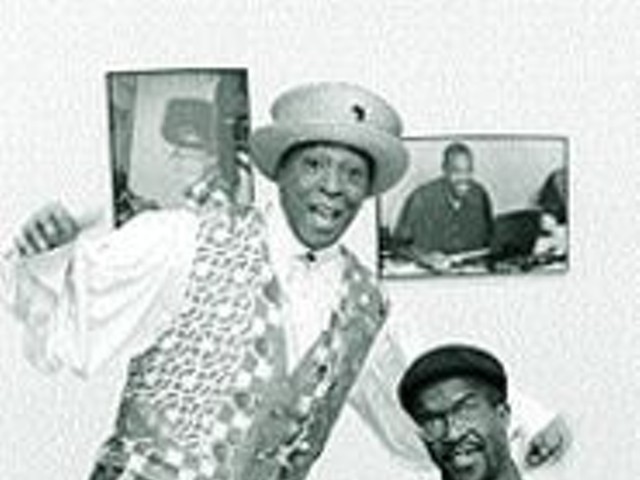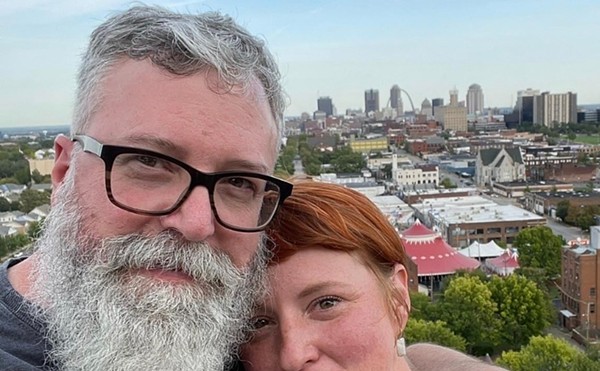Hidden pleasure became passé in '60s, the decade of exposure. I Am Curious (Yellow), out of Sweden, was lucky enough to have the U.S. Customs Service attempt to keep it out of the country (nudity, simulated sex), which allowed it to gross a whopping (in those days) $20 million.
When a taste for the explicit is awakened, the only thing to do is to feed it and make it more explicit. In the early '70s, Deep Throat and Behind the Green Door did boffo box office, moving "dirty" movies out of the Shriners' basement and into the mass market. Shady little theaters appeared in towns across America. Smut became an industry.
Not in St. Louis, though. Various cultural historians consulted for this article did not see Deep Throat or Behind the Green Door or even I Am Curious (Yellow) in St. Louis. They were never shown here. St. Louis was, and is, a soft-core town only. Dirty movies could only be found across the river, unless, as one local confides, you were invited to policemen's parties, where confiscated merchandise was often shown.
There were theaters that tried to get by presenting movies such as Candy Stripers, which featured naked women and simulated sex -- no male frontal nudity, no pubic hair, no actual penetration and certainly no money shots (as are now seen in legit films such as Happiness and There's Something About Mary). Downtown there was the Towne, of which there is not even a palimpsest to be found anymore. There was the Olympia Drive-in on St. Charles Rock Road. The Fine Arts, on Olive -- a beautiful building with glass brick, ornate ironwork and little faux gas lamps -- is for sale. Currently the home of Higher Heights Christian Church, it went through various incarnations in a brief span of time, from soft to hardcore to art house.
The "golden age" of pornography, which is chronicled so adeptly in the hit film Boogie Nights, passed by with St. Louis hardly noticing. For a brief period during the '70s, porn filmmakers aspired to make more than just fuck movies. They entertained such narrative conventions as plot and character. They thought of how the subject of sex was ideal for satire. Films such as The Opening of Misty Beethoven got made, managing to be both sexy and funny.
Then video, and too much cocaine, killed the pornography star. Video was cheap to produce and cheap to market, and people could entertain their private kinks in their own homes -- the fraternal brothers were there only if you wanted them. The triple-X theaters began closing in the '80s.
"Who would go to a theater when they can get their rocks off at home?" says Ed, the owner/manager of the Colony, the last remaining triple-X house in the region. Ed (who really isn't interested in being in the newspapers, so leave it at Ed) has operated the Colony for 30 years. A dilapidated wooden structure on a foundation of cinderblocks, the Colony sits unobtrusively on the East St. Louis/Washington Park border, not far from the Grace Union Methodist Church and close to a new housing development in one of the worst zones of poverty in the region. To Ed, the rows of new homes mean nothing more than "more shootin'," which he's prepared for -- the butt end of a .45 is prominently displayed in the pocket of his blue jeans.
Dressed in a white T-shirt that reveals a bit of a paunch, Ed has white hair and dark eyebrows. His face is constantly on the verge of grimacing, which he does with each drag off his cigarette. He is one tough guy and wants people to know it. In the Colony's reception booth, which sits high above the patrons, there are a number of surveillance monitors with which Ed and the personnel keep an eye on things. If there's trouble, "I start shootin'," Ed asserts. "I don't give a shit." The original Colony (this is actually the Colony II) was farther down the street, into East St. Louis. Because Trouble knew that Ed would shoot, Trouble stayed on the other side of the street from the old Colony.
Tough guy that he is, Ed still lets out a brief sigh of ennui when talking about the days since the advent of video: "It's a dying business. I'd sell it if I could." When asked about the "golden age" of porno, when performers such as John Holmes (Boogie Nights is loosely based on his career) were stars, Ed dismisses the nostalgia, saying, "Hell, I was in business before all those motherfuckers."
Ed was against video porn at the outset, and he isn't an advocate of the Internet either, reasoning that such material needs to be kept in its place. Accessibility is the issue with him, the logic being that people need to keep their dark side at a distance from their everyday lives. A theater such as the Colony provides the distance so that the home life can be, well, just like home.
There's a through-the-looking-glass feeling of dislocation at the Colony. The reception booth is perched high above; incense burns; a dark corridor leads past a door marked "Couples Only" to a dimly lit lounge with a bar, tables, aquariums and intimate booths. Ed built the lounge to compete with the video and Internet revolutions.
It could be a "swingers" bar anywhere, except for the couple seated at one table watching a monitor that is showing a woman performing oral sex on a man (who is wearing socks!). The scene is shocking, even disorienting, at first, but as the video performance goes on and on and on, shock gives way to monotony. At the bar, a man and two women sit talking about the day's work. More couples arrive, mostly on the older side of middle age, as the evening moves on.
Couples make up the Colony's regular clientele, says Ed, mostly married couples. He says they come from all over the country; he doesn't know how they learn about the place. He provides them with security -- .45 on hip -- and he keeps out the "sleazeballs": A dress code rules out baseball caps and tank tops, which is apparently sleazeball fashion. Ed has no interest in filling the place with bodies. On weekends, the entry fee for couples is $25 -- "If they don't like it, they can go the fuck somewhere else." On this night, the clientele is mostly cozying up to the bar -- the videos running on and on in the background, the same action repeated with different partners, over and over.
In the four auditoriums, videos are continuously projected on the screens. Another sign of the demise of the form: Nobody seems to care what's playing at any given time. Ed says he doesn't have anything to do with what's shown. He owns a large selection of tapes, and he lets the personnel choose what plays. "I don't need to see a porno movie," he says. "There's nothing I'm going to see that's new. I never watch them."
So they just go on and on -- on this night to empty theaters, although one young man in jeans and a T-shirt moves anxiously from one screen to another, in search of something that might hold his interest.
There's an "all-male" screen with homosexual porn, showing performers involved in a three-way. A slim storyline has something to do with an interview, the last line of the film being "You've got the job."
There are two "coed" screens (the screens, by the way, are just like the ones the teacher pulled down in health class when it was time for a hygiene documentary). The sound quality is abysmal, but because there's not even an audience, what does it matter? Furniture is stacked beneath one screen. What goes on behind the "Couples Only" door, only the couples know.
When a storm hits, rain begins streaming in from the roof in one of the auditoriums. The feeling of something wet dripping on the neck in a porno theater -- even if that porno theater is a fading landmark -- is a signal that it's time to leave.
There are other "adult entertainment" houses in Washington Park. The parking lot of C-Mowes Show Club is three-quarters full. The building is as shabby as the Colony but glows with neon signage. Next door is the Chameleon Club, a squat little building painted hot pink. A ways down the road from the Colony is Dollie's Playhouse, where in the parking lot a trucker leaves his rig and heads toward the entrance, hitching up his pants and swaggering like John Wayne on the way to a dusty saloon.
In another part of town is the bane of the Colony's existence, Fish's Adult Video, where a number of cars are parked.
It's hard to connect the word "pleasure" to any of these places. They all have the least appealing, uninviting edifices, hinting of even more repellent things inside. But then, the darkness, the seediness -- that is the turn-on for some, there in the anonymous emptiness of Middle America.
The night turns inky-dark. A pack of dogs marches along the roadside in single file. Out here where people are mired in poverty, and where those with mobility drive by unawares at 80 mph, these obscure shops appear. Although they purport to be about fantasy, they seem to be more about banality, as if the values of those Kiwanis and Odd Fellows inculcated themselves into the erotic imagination and never left. Out of America's heartland springs perversity along the corn rows, an act of denial against the vast acres of loneliness.





